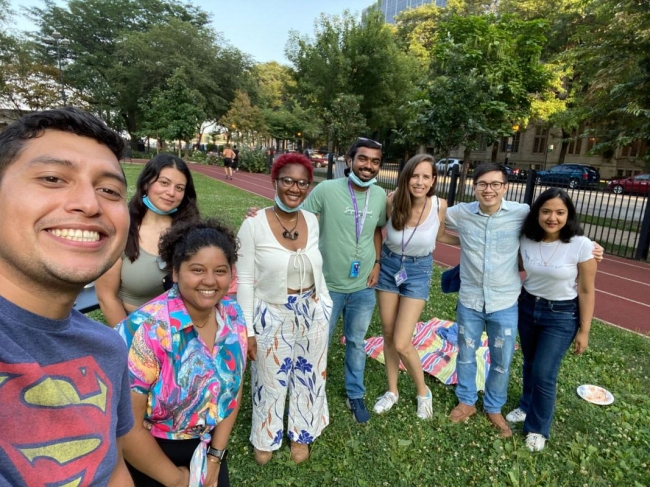You have /5 articles left.
Sign up for a free account or log in.

Northwestern University
HOUSTON—How can a college recruit more minority students? The answer seems to frustrate many colleges, whose leaders say they want more diversity on their campuses. Also frustrated are the people (many of them minority professionals themselves) tasked with coming up with ideas for how to recruit more students. At a panel here, at the annual meeting of the National Association for College Admission Counseling, four of those individuals explained their perspectives. They said their efforts need more money and more support from top levels of the administration. But they also said that the strategies that work are known and can succeed (at least if the Supreme Court doesn’t outlaw them).
Amethyst Black, associate director of admissions for access and inclusion at Rice University, set up the conversation as being about BIPOC students: Black, Indigenous and people of color. She said the term was most used in the summer of 2020, when anger over police violence against Black people (George Floyd was murdered that May) merged with anger over campus issues for many people. Of course, this was also the time when many people were not on a campus due to the pandemic.
But Black stressed that colleges have no choice but to take BIPOC recruitment seriously. White students are themselves becoming a minority (among high school graduates), she said. Any college leader should care, she said.
Justin Childs, admissions coordinator at Florida International University, then talked about the impact of COVID-19. While many colleges lost minority enrollments, he said the real impact will come due to the lost enrollments (of all students, but especially minority students) in elementary and secondary schools. These students are much less likely to enroll in any college, he said.
Miya Walker, director of admission at Agnes Scott College, in Georgia, then reviewed challenges that can deter BIPOC students from enrolling, including a lack of funds (or a sense that there is no money for them) and geographic challenges. She said it can “be challenging” to recruit to Southern states when political leaders make decisions that do not appeal to young people. “The political landscape matters,” she said.
She focused on “belonging,” which many minority students say is important, and an environment that colleges strive to create. “What does this look like in admissions?” she asked.
Walker said belonging is present when financial aid is plentiful enough for BIPOC students, and that doesn’t mean large loans.
She said that campus visits matter, and she sees it as key to include a parent in any “fly-in” program. Parents are being asked to trust that their children will be safe in (in Agnes Scott’s case) the Atlanta area, she said. Many parents don’t have a strong sense of the city, or of cities generally, Walker said.
“It takes money to do these things,” she said. “It takes representation.” Walker said those who work in the field need to be willing to change jobs if they aren’t receiving the support they need.
What Forms of Communication?
Ian W. McLean, senior assistant director of admissions at Northwestern University, said he has seen programs for parents make a real difference. And for many Latino families, those programs need to be offered in Spanish in addition to English.
“Families are listening in on those Zoom calls,” he said.
Childs said, “Communication is key.”
“Snapping a picture of some BIPOC students on a flyer isn’t going to make it anymore,” he said.
Minority students need to hear from other minority students about a college, warts and all, he said. And those students “need to come from the community” from which the student being recruited also comes, he said.
The issue of communication comes up when reading students’ submissions as well, Walker said.
She described an admissions officer reading an application from a student and classifying the student as African American. But what if the student was the offspring of a Jamaican mother and a Haitian father? This situation raised the issue of whether an admissions officer has the context of a student.
“Knowing what you are reading is necessary and imperative,” she said.
What About Implicit Bias?
Another session at the NACAC meeting dealt with implicit bias on letters of recommendation. The speakers at this session did not, as some have, argue for the elimination of letters of recommendation in the college application process. Those who have done so have noted that counselors and teachers at most public high schools are responsible for many more students than at private high schools, so letters impose unpaid work on them and indirectly hurt their students.
Rather, the counselors spoke of the implicit bias that shapes what teachers and counselors say, even in cases where they are not trying to hurt a student’s chances.
At the beginning of the sessions, Alyson Tom, associate director of college counseling at the Castilleja School, in California, told a story about a recent visit she made with her 2.5-year-old to see a new doctor. She described getting help with finding the doctor’s office. There were receptionists, nurses and a physician. She told the story without identifying anyone by gender or race and asked those in attendance whether they had made any assumptions.
She contrasted that story with a real letter she saw from a teacher in a previous job. The letter, and many like it, described an Asian applicant as “quiet.”
Tom urged those in attendance to avoid words like “quiet” or saying that a Black student was very “articulate,” with the implication that this is somehow unusual.
Moira Poe, senior associate director of undergraduate admissions at Yale University, said that admissions officials like to talk about “holistic admissions” without thinking about “how we read the profile.”
With admissions officers looking for context, every word matters, she said.
She said that, when discussing implicit biases, it’s important to remember that everyone has them.
Tom said one way to fight implicit bias is to take the time to really think about the students one is reviewing.
But she is not sure awareness alone will work. She suggested looking at all the reviews one writes. If men’s reviews are longer then women’s reviews, as they typically are, that’s a problem.
And she suggested an “audit” of reviews. Counselors may want to ask a fellow counselor to read their reviews, looking for bias. Or counselors may want to read the reviews a teacher writes.
Tom stressed that these moves were a way to reflect the reality that too many students are hurt by bias in reviews.








